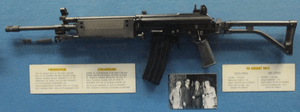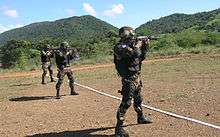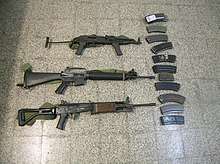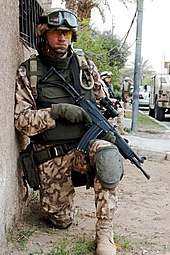IMI Galil
| Galil | |
|---|---|
 Galil ARM | |
| Type |
Assault rifle Battle rifle |
| Place of origin | Israel |
| Service history | |
| In service | 1972–present[1] |
| Used by | See users |
| Wars |
Nicaraguan Revolution[2] Lebanon War War in Somalia South African Border War First Congo War Congo Civil War[3] War in Afghanistan Iraq War Insurgency in the Philippines Guatemalan Civil War Colombian Armed Conflict Nepalese Civil War |
| Production history | |
| Designer |
Yisrael Galil Yakov Lior |
| Manufacturer |
Manufactured by: Licensed by:
|
| Variants | See Variants |
| Specifications | |
| Weight |
|
| Length |
|
| Barrel length |
|
|
| |
| Cartridge | |
| Action | Gas-operated, rotating bolt |
| Rate of fire | 630–750 rounds/min |
| Muzzle velocity |
|
| Effective firing range | 300–500 m sight adjustments |
| Feed system |
|
| Sights | Flip-up rear aperture with protective ears, flip-up tritium night sights, hooded front post |
The Galil is a family of Israeli made automatic rifles designed by Yisrael Galil and Yaacov Lior in the late 1960s, and produced by Israel Military Industries (IMI) (now called Israel Weapon Industries (IWI)). The design is basically a clone of the Valmet Rk 62, which is itself a copy of the Soviet AK-47.[6] "In fact, the first Galils were manufactured using Valmet Rk 62 receivers."[7] Most Galils are chambered for either the 5.56×45mm NATO or 7.62×51mm NATO cartridges. The Galil series of weapons is in use with military and police forces in over 25 countries.
The Israeli army used the 5.56×45mm NATO caliber Galil in three basic configurations. The Automatic Rifle Machine-gun (ARM) with a bi-pod, wire-cutter and carrying handle would become the standard service rifle issued to front line infantry troops. This is the version that famously features a bottle opener in the front handguard.[8] The Automatic Rifle (AR) without the bi-pod, wire-cutter and carrying handle was issued to support troops and military police units. The Short Automatic Rifle (SAR), with a shortened barrel, was issued to vehicle crews, army staff and specialty troops.
A modernized version of the Galil is currently in production in multiple calibers, called the Galil ACE.
History
In the late 1950s, the Israel Defense Forces adopted the FN FAL battle rifle chambered for the 7.62×51mm cartridge. Two models were fielded: the "Aleph" individual weapon and the "Bet" squad automatic weapon. The FAL first saw major combat with the Israelis during the Six-Day War in 1967. Although Israel won decisive victories, the FAL showed its limitations in IDF service; a common complaint was that the sand and dusty conditions caused the weapon's malfunction, but this was later attributed to the lack of maintenance given by IDF conscripts. Furthermore, it was a long and bulky weapon. Its length and malfunctions became such pervasive issues that during the 1973 Yom Kippur War, some soldiers armed themselves with an Uzi submachine gun with an extended barrel.[9][10]
During the Six-Day War, the Israelis captured thousands of AK-47 assault rifles and evaluated them. The rifle proved far more reliable and controllable than the FAL, and the required maintenance was low enough that the conscripted troops would not require more stringent regulations of the weapon's care. Because of this, the IDF began the process of procuring a new automatic rifle that would offer the same benefits of low-maintenance as the AK-47 but with the accuracy of the M16 and FAL. Several weapons were submitted for the lucrative deal of becoming the Israeli Army's standard-issue assault rifle; America offered the M16A1 and Stoner 63 series and Germany offered the HK 33. The AK-47 design was also considered, but difficulty in procurement limited its viability.
However, an indigenous design was offered by Uziel Gal, creator of the Uzi submachine gun, but was ultimately found too complex and unreliable for adoption.[10] Another indigenous design was offered by Yisrael Galil. This rifle was based on the 7.62×39mm Valmet Rk 62. "In fact, the first Galils were manufactured using Valmet Rk 62 receivers."[11] Galili's rifle was chambered for the American 5.56×45mm round, originally the US M193 55-grain version. At the time, the United States was replacing France as Israel's main partner and weapons supplier. Tests conducted from the end of the 1960s to the early 1970s led to Galili's rifle emerging as the winner. However, issuing of the Galil was delayed by the sudden onset of the Yom Kippur War in 1973.[9][10][12]
The Israeli army used the 5.56×45mm NATO caliber Galil in three basic configurations. The Automatic Rifle Machine-gun (ARM) with a bi-pod, wire-cutter and carrying handle would become the standard service rifle issued to front line infantry troops. This is the version that famously features a bottle opener in the front handguard.[13] The Automatic Rifle (AR) without the bi-pod, wire-cutter and carrying handle was issued to support troops and military police units. The Short Automatic Rifle (SAR) with a shortened barrel was issued to vehicle crews, army staff and specialty troops.
Although the Galil was the official service rifle of Israel from the mid-1970s to the early 1990s, it was never the principal rifle used in terms of numbers. Around 1975, 60,000 M16A1s from the U.S. Military Aid Program (MAP) began to arrive for Israel, which were quickly integrated into IDF service. As the cost of producing the Galil for all IDI forces was very expensive, Israel continued to purchase M16s and later M4s with military credit from the USA, replacing many Galils then in service. In general, Israeli troops preferred the M16, because it was lighter and more accurate, if not quite as rugged and reliable. When the M4 came along this weapon with its short length and light weight became even more attractive, along with the M4's versatility in using different optics without losing zero when the weapon was disassembled, plus other rail-mounted accessories. The M16 and M4 also proved to be better suited to the grenade launching role using the US M203 integrated 40 mm launcher. Israeli paratroops in particular preferred the M4 carbine to the Galil, while the M16 was retained for training recruits, reservists, Artillery Corps, and the Armored Corps (Heil HaShiryon).[14]
By 2000, both the Galil ARM and AR variants were phased out from standard issue and replaced by M4 and M16 variants. The Galil SAR (G'lilon) was kept in use by some rear-line services, including the Knesset Guard[9] and the Armored Corps, until 2005.
For a short time, the Galil was licensed by NWM (Nederlandsche Wapen-en Munitiefabriek) De Kruithoorn N.V. for sales to a NATO country.[15]
Design details
Operating mechanism
The Galil series of rifles are selective fire weapons operated by a Kalashnikov-pattern gas-driven piston system with no regulator. The weapon is locked with a rotary bolt with two locking lugs that lock into recesses milled into the receiver.
When fired, a portion of the propellant gases are evacuated into the gas cylinder through a 1.8 mm (0.07 in) port, drilled at a 30° angle in the barrel, and a channel in the gas block. The high-pressure gases drive the piston rod (which is attached to the bolt carrier) rearward. During this rearward movement, a cam slot machined into the bolt carrier engages a cam pin on the bolt and rotates the bolt, unlocking the action. The arrangement of parts on the bolt carrier assembly provides for a degree of free travel, allowing gas pressure in the barrel to drop to a safe level before unlocking. To the immediate rear of the chrome-plated piston head is a notched ring which provides a reduced bearing surface and alleviates excess gas build-up. As the bolt carrier travels back, it compresses the return spring guided in a hollowed section of the bolt carrier and the return energy contained in the spring drives the moving assembly back forward, stripping a new round from the magazine and locking the action. The cocking handle is attached to the bolt carrier on the right side of the receiver and reciprocates with each shot; the handle is bent upwards allowing for operation with the left hand while the shooting hand remains on the pistol grip.
The ejection of spent cases from the Galil is sometimes a violent action. Cases can be dented by the ejector and be thrown as much as 40 ft away from the rifle in some cases, depending on position.[12]
Features
The Galil is hammer-fired and has a trigger mechanism patterned after the trigger used in the American M1 Garand.[16] The rifle's fire selector switch has three positions: S-A-R. The standard AK-47 style selector is retained on the right face of the receiver, and a dual thumb-selector is present on the left face above the pistol grip for easier manipulation.[17] Pushing the left-selector to the rear position "R" (British terminology for "repetition"), provides semi-automatic fire. Pushing it to the middle position "A" produces fully automatic fire. Pushing the lever fully forward to "S" will activate the safety. Some models use a reverse-linkage RAS mechanism that performs the opposite action; pushing forward sets the rifle to Repetition or Automatic, and pulling rearward engages the safety,
The Galil prototypes used a stamped and riveted sheet metal steel receiver, but due to the higher operating pressures of the 5.56×45mm cartridge, this solution was discarded and the designers turned to a heavy milled forging. As a testament to its heritage, early prototypes were fabricated using Valmet Rk 62 receivers manufactured in Finland.[16] All exterior metal surfaces are phosphated for corrosion resistance and then coated with a black enamel (except for the barrel, gas block and front sight tower). The machined solid steel billet action avoided cracking problems the AK-series had with steel stamped sheet actions, but this made the Galil heavier.[9]
The Gas-Block, handguard retainers and folding-stock mechanism components are cast pieces that are finish-machined and accordingly fitted. The sighting arrangements are also entirely cast and machined for greater durability. The only stamped components on the Galil are the magazine-catch, trigger guard, dust cover (on the R5 and R6 the rear handguard-retainer is stamped versus cast) and the magazines.
The weapon is fitted with a high-impact plastic handguard and pistol grip and a side-folding (folds to the right side) tubular steel skeleton stock. The rifle can be used with a sound suppressor. The weapon features a bottle opener in the front handguard and wire cutter built into the bipod.[18] The bottle opener feature was included to prevent damage to magazines being used to open bottles, due to the large civilian reservist components of the IDF. Use of magazines to open bottles was a common source of magazine lip damage with Uzi submachine guns. Wire cutters were included to reduce the time necessary for IDF troops to cut down wire fences common to rural areas in Israel.
Barrel
Early production models were supplied with barrels that had six right-hand grooves and a 305 mm (1:12 in) rifling twist (optimized for use with M193 ammunition), while recent production models feature a 178 mm (1:7 in) twist barrel with six right-hand grooves (used to stabilize the heavier SS109/M855 projectile). The barrel has a slotted flash suppressor with 6 ports and can be used to launch rifle grenades (such as the BT/AT 52) or mount a bayonet lug attachment (it will accept the M7 bayonet).[16]
Feeding
The Galil is fed from a curved, steel box magazine with a 35-round capacity (SAR and AR versions), a 50-round capacity (ARM model) or a special color-coded 12-round magazine blocked for use exclusively with ballistite (blank) cartridges, used to launch rifle grenades. The magazine is inserted front end first in a similar manner to the AK family. An optional magazine adaptor enables the use of M16 type STANAG magazines.[16][17] Some who have used the Galil ARM with the 50-round magazine have noted that it is difficult to engage targets at elevated heights while firing on the ground in the prone position due to the magazine's extended length.[12]
Sights
The L-shaped rear sight has two apertures preset for firing at 0–300 m and 300–500 m respectively (the rear sight can only be adjusted for elevation). The front post is fully adjustable for both windage and elevation zero and is enclosed in a protective hood. Low-light flip-up front blade and rear sight elements have three self-luminous tritium capsules (betalights) which are calibrated for 100 m when deployed. When the rear night sight is flipped up for use, the rear aperture sights must be placed in an offset position intermediate between the two apertures. Certain variants have a receiver-mounted dovetail adapter that is used to mount various optical sights.
Stock
The standard stock found on the Galil is a rough-copy of the FN-FAL Paratrooper stock, with modifications for simpler production and ease of use. Unlike the FAL folding stock, the Galil uses no locking button and is operated entirely by a pin and spring pivoting mechanism; to fold the stock, the "L" bracket on the stock portion is pressed down to where the spring is fully compressed and the entire stock is allowed to pivot on the buttstock hinge. The same operation is done for unfolding to the stock to the open-position.
The bracket and knuckle assemblies feature camming surfaces that allow the emergency unfolding of the stock by simply pulling the buttstock rearwards, however this should generally be avoided as it will wear down the mechanism rapidly over time, and lead to the stock wobbling in both positions.
There were six different types of Galil folding stock (not including the Micro or Galatz models) that were utilized over time on the Galil and R4 series of weapons. Wooden AK47 type buttstocks were also offered by request, although none are known to have been used by any militaries and were mostly relegated to the civilian market.
Contrary to popular belief, all Galil folding stocks are made of tubular aluminum like its FAL rendition; steel was never used, as it would have added too much additional weight, and the aluminum stocks were more than durable for standard firing and rifle-grenade usage.
Variants
AR

The standard rifle version which is fitted with a high-impact plastic handguard and pistol grip, a side-folding (folds to the right side) tubular metal skeleton stock as fitted to all variants except the Galil Sniper. The 5.56mm NATO version uses a 35-round magazine and a has a 460 mm (18.1 in) barrel. While the 7.62mm NATO version uses a 25-round magazine and has a 535 mm (21.1 in) barrel.
SAR
The SAR carbine variant (aka: G'lilon), is configured with a shorter barrel. Due to the shorter barrel a corresponding shorter piston and gas tube as well as a unique gas block are found on the SAR. The SAR variant saw the longest service life in the IDF, being in use with the Armored Corps until 2005. The 5.56mm NATO version uses a 35-round magazine and a has a 332 mm (13.1 in) barrel. While the 7.62mm NATO version uses a 25-round magazine and has a 400 mm (15.7 in) barrel.
ARM

The ARM light machine gun variant is additionally equipped with a carrying handle, folding bipod and a larger wooden handguard. The wooden handguard remains cooler during sustained automatic fire and has grooves for bipod storage. When folded, the bipod's legs form a speed chute for rapid magazine insertion; the bipod will form a wire cutter and the rear handguard ferrule, which retains the bipod legs, can be used to open bottles by design, in order to prevent soldiers using magazine lips for this purpose which damaged them.[16] The 5.56mm NATO version uses a 35-round magazine and a has a 460 mm (18.1 in) barrel. While the 7.62mm NATO version uses a 25-round magazine and has a 535 mm (21.1 in) barrel.
MAR
.jpg)
The most recent addition to the Galil family of weapons is the MAR compact carbine, which retains the internal features of the original Galil with a completely new frame, operating system and an even shorter barrel. Introduced to the public at the 2nd International Defence Industry Exhibition in Poland in 1994, the weapon was developed for use with the army and police special units, vehicle crews, army staff, special operations personnel and airborne infantry.
The MAR, or the Micro Galil, is a reduced-size version of the Galil SAR (706 mm stock extended / 465 mm folded), weighing 2.98 kg (6.57 pounds) empty. Compared to the original carbine, the MAR has a shortened barrel (210 mm), receiver, piston, gas tube and foregrip. The firearm is fed from a 35-round steel magazine which can be clipped together to increase reload speed. The MAR has the same rate of fire (630-750 rounds/min) as other 5.56mm Galil models. An optional magazine adapter inserted inside the magazine well allows the use of standard 20- and 30-round M16 magazines. The lever safety and fire selector (located on both sides of the receiver) has four settings: "S"—weapon is safe, "A"—automatic fire, "B"—3-round burst, "R"—semi-automatic mode. The barrel has a multifunction muzzle device. The MAR is equipped with a folding tubular aluminum stock and a flip aperture sight with two settings: 0–300 m and beyond 300 m. The MAR can also be equipped with a night vision device (attached through an adapter mounted to the left side of the receiver), a daytime optical sight (mounted via a receiver cover adapter), low-light sights with tritium illuminated dots, a vertical forward grip with integrated laser pointer, silencer and a nylon sling. Upon request, the weapon can be supplied with a bolt catch, plastic magazines weighing 0.164 kg or an enlarged trigger guard for use with gloves.
The MAR has undergone several changes over time, and it is worth noting that it may also be found with a polymer-coated aluminum stock or an all-polymer stock. The Model 699 is available with a 267 mm barrel and optional left-side charging handle which is welded onto the left side of the bolt carrier and protrudes through a slot cut in the receiver cover that is covered by a spring-loaded cover while the bolt carrier is forward.
Galil Sniper

The 7.62mm Galil Sniper (aka: Galil Tzalafim or "Galatz") is a derivative of the ARM that is used in conjunction with high-quality 7.62×51mm NATO ammunition for consistent accuracy.[19]
The precision rifle is a semi-automatic-only rifle with a similar operating system to other Galil variants, but optimised for accuracy. The rifle is fed from a 25-round box magazine. It uses a heavy-profile match barrel that is heavier than that used on other variants. It is fitted with a multi-functional muzzle device, which acts as both a flash suppressor and a muzzle brake. It can be replaced with a sound suppressor, which requires the use of subsonic ammunition for maximum effectiveness.
The weapon was modified with a two-stage trigger mechanism with an adjustable pull force, a wooden buttstock that folds to the right side of the weapon and a heavy-duty bipod, mounted to the forward base of the receiver housing that folds beneath the handguard when not in use. The buttstock is fully adjustable in length and height and features a variable-height cheek riser. The rifle comes with mechanical iron sights and an adapter used to mount a telescopic day sight (Nimrod 6×40) or a night sight. The mount is quick-detachable and capable of retaining zero after remounting. The precision rifle is stored in a rugged transport case that comes with an optical sight, mount, filters, two slings (for carrying and firing) and a cleaning kit. Recent production models feature synthetic plastic furniture and a skeletonized metal stock.
The Galatz was first introduced in 1983.[20] The SR-99 is a modernized version of the Galatz featuring an adjustable skeleton stock instead of a wooden stock, synthetic handguard, and a synthetic pistol grip. It is somewhat less rugged, but more ergonomic.[21]
The Galatz is made under license by Punj Lloyd Raksha Systems.[22][23]
Other variants
- Magal: A law enforcement carbine variant of the Galil MAR chambered in .30 Carbine. It uses the same 15- and 30-round magazines as the M1 Carbine, as well as a dedicated 27-round magazine incorporating a bolt hold-open device. First issued in 1999, the MAGAL was withdrawn from service in 2001 after numerous complaints of malfunctions.
- Marksman Assault Rifle Mark 1: 5.56mm designated marksman rifle introduced in 1996. Has a scope and padded stock.[10]
- Golani: A civilian version with a new-production milled semi-automatic receiver built in the United States. All other components are original IMI Galil production parts.

- Galil ACE: The new generation of the Galil rifle, utlizing a left-side mounted charging handle, a spring-loaded dust cover, and a plastic or polymer lower receiver designed to lower cost and weight. The ACE has been produced in three versions (Micro, SAR and AR) chambered for 5.56mm NATO, 7.62mm Soviet M43 and 7.62mm NATO. All variants have up to five picatinny rails for mounting optical devices and accessories, It can be stripped without any tools.
Foreign Variants
Italian Variants
The Italian firearms manufacturing firm Vincenzo Bernardelli manufactured under license quantities of the Galil assault rifle in two different models for governmental use in the 1980s.[24][25] The Bernardelli Mod.377 VB-STD assault rifle was an outright clone of the Galil AR/ARM variant.
The Bernardelli Mod.378 VB-SR assault carbine was a modified clone of the Galil SAR with a different magazine well that accepted STANAG magazines, much similar in concept and look to the above-mentioned optional magazine adapter currently available for the Israeli-made models, except that the Bernardelli VB-SR could be manufactured with permanent STANAG magazine well modification on demand.[24] The rifles competed to the trial for the adoption of a new 5.56×45mm NATO caliber rifle, but lost to the Beretta 70/90 assault weapons system.[24][26]
Both rifles have the A-R-S trigger group (S-E-F; Safe, Semi-Auto, Full-Auto).[27][24] The STD can be adopted to mount the M203.[24]
The VB-SR's parts can be changed with the R5 and the Galil SAR.[24]
Myanmar variants
The MA series, which means Myanmar Army,[28] are Myanmar variant of the Galil assault rifle with some localised modifications produced with assistance from Israel. The series are sometimes mentioned in firearms literature as the EMERK-3.[29] The rifles are manufactured by Myanmar Fritz Werner Industries.[29]
They were introduced with wooden handguards before initial models were made with brown polymer furniture and rounded, smooth pistol grips.[30] Later versions were produced with black furniture and clear cut Galil grips, designated as the Mk II.[30][31] The bipod was not made standard with the MA-1s with cleaning kit stored in a hollow space in the buttstock.[32]
Serial production started in 2002 after signing an agreement with IMI.[33] The assault rifles were mostly made at Ka Pa Sa No 1 or DI-1, a factory located near Inya Lake.[34][28] The MA rifles are made with ventilated handguards and horizontal charging handles, unlike the Galil which has a vertical charging handle.[29] They can also use 5.56 NATO magazines made for the IMI Galil.[29]
By 2009, it was reported that the army was almost fully equipped with the MA series.[33] They are not only used by the Myanmar Army, but they've been seen in the arsenals of the Karen National Liberation Army[35] and the Ta'ang National Liberation Army[36], captured from Myanmar army forces[35] or from defecting soldiers.[37]
They consist of the follow variants:[30][33]
- MA-1: Standard assault rifle with a bayonet lug for the option to have a bayonet mounted.[29]
- MA-2: Light machine gun version with a heavy barrel and a bipod mounted.[38] It was originally developed without the idea of using a drum magazine, relying on assault rifle magazines.[39] It's usually seen with the MA-15, a clone of the MG 3.[39]
- MA-3: Carbine version with a folding metal buttstock.[40]
- MA-4: A version of the MA-1 equipped with an underbarrel grenade launcher.[40]
- MA-S: Known as Myanmar Army Sniper, a designated marksman rifle variant based on the MA-2 with the design being influenced by the Dragunov SVD.[41] It's chambered in 7.62x51 NATO caliber and fires from a 10-round magazine.[41]
South African variants
The Vektor R4 is a South African variant of the Galil ARM assault rifle[42][43] with several modifications; notably, both the stock and magazine are made of a high-strength polymer and the stock was lengthened, adapting the weapon for the average South African soldier.[42]

The South African Navy, South African Air Force and South African Police Service adopted a short carbine version of the 5.56mm Galil SAR, which was license-manufactured as the R5. The R5, when compared to the larger R4, has a barrel that is 130 millimeters (5.1 in) shorter, together with a shorter gas system and handguard. It also lacks a bipod, and the flash hider does not support rifle grenades.
In the 1990s, an even more compact personal defence weapon variant of the R5 was developed for armored vehicle crews, designated the R6, which has a further reduced barrel and a shortened gas cylinder and piston assembly.
Lyttleton Ingenieurs Werke (LIW)/Denel Land Systems (DLS) also introduced a line of semi-automatic variants of the R4, R5 and R6 called the LM4, LM5 and LM6 respectively, built for civilian and law enforcement users.
| Vektor Rifle | Specifications | ||||||
|---|---|---|---|---|---|---|---|
| Model | Overall Length | Barrel Length | Weight | ROF | |||
| R4 Rifle | 1,005 mm (39.6 in) stock extended 740 mm (29.1 in) stock folded | 460 mm (18.1 in) | 4.3 kg (9.48 lb) | 650-700 rpm | |||
| R5 Carbine | 877 mm (34.5 in) stock extended 615 mm (24.2 in) stock folded | 332 mm (13.1 in) | 3.7 kg (8.2 lb) | 650-700 rpm | |||
| R6 PDW | 805 mm (31.7 in) stock extended 565 mm (22.2 in) stock folded | 280 mm (11.0 in) | 3.6 kg (7.9 lb) | 585 rpm | |||
The R4's parts can be interchanged with the Galil ARM with Valmet rifle magazine made for 5.56 NATO caliber being usable for the R4.[44]
Users





















































See also
- Rk 62 – The Finnish weapon upon which the Galil is partly based.
- IWI ACE – lightened and updated version of the IMI Galil by the parent company (renamed from IMI)
- R4 assault rifle – South African licensed version
- Vektor CR-21 – A South African bullpup rifle based on the R4/Galil
- Zastava M21 – A Serbian 5.56mm caliber rifle based upon the Kalashnikov action.
References
- 1 2 3 Bishop, Chris. Guns in Combat. Chartwell Books, Inc (1998). ISBN 0-7858-0844-2.
- ↑ Jurado, Carlos Caballero (1990). Central American Wars 1959-89. Men-at-Arms 221. London: Osprey Publishing. p. 44. ISBN 9780850459456.
- ↑ Small Arms Survey 2003, p. 267.
- ↑ http://www.thehindu.com/news/national/punj-lloyd-iwi-of-israel-make-small-arms-in-india/article18383248.ece
- ↑ https://www.strategicfront.org/israeli-assault-rifles-journey-prospects-india/
- ↑
- ↑ https://www.americanrifleman.org/articles/2017/12/28/galil-ace-iwi-brings-the-ak-into-the-modern-era/ Galil ACE: IWI Brings the AK Into the Modern Era. by Jeremiah Knupp. December 28, 2017
- ↑ Sweeney, Patrick (2009-01-13). The Gun Digest Book of the AK & SKS: A Complete Guide to Guns, Gear and Ammunition. Gun Digest Books. ISBN 0-89689-678-1.
- 1 2 3 4 Galil Ace 5.56 – SAdefensejournal.com, 29 May 2013
- 1 2 3 4 IMI Galil ARM/SAR – Militaryfactory.com
- ↑ https://www.americanrifleman.org/articles/2017/12/28/galil-ace-iwi-brings-the-ak-into-the-modern-era/ Galil ACE: IWI Brings the AK Into the Modern Era. by Jeremiah Knupp. December 28, 2017
- 1 2 3 Galil Rifle History – Dnmsport.com
- ↑ Sweeney, Patrick (2009-01-13). The Gun Digest Book of the AK & SKS: A Complete Guide to Guns, Gear and Ammunition. Gun Digest Books. ISBN 0-89689-678-1.
- ↑ Rappoport, Elie, Micro Tavor vs. the M4/M16: Core Of The IDF", Draft IDF, 28 December 2017, retrieved 11 March 2018
- ↑ https://web.archive.org/web/20070928075105/http://collectie.legermuseum.nl/sites/strategion/contents/i004532/arma38%20kalasjnikov.pdf
- 1 2 3 4 5 Kokalis, Peter (2001). Weapons Tests And Evaluations: The Best Of Soldier Of Fortune. Boulder, CO: Paladin Press. p. 253. ISBN 1-58160-122-0.
- 1 2 http://modernfirearms.net/en/assault-rifles/israel-assault-rifles/galil-eng/
- ↑ Sweeney, Patrick (2009-01-13). The Gun Digest Book of the AK & SKS: A Complete Guide to Guns, Gear and Ammunition. Gun Digest Books. ISBN 0-89689-678-1.
- ↑ "Galil 7.62mm semi-automatic sniper rifle". Retrieved 25 October 2014.
- ↑ IMI Galil Sniper (Galatz) – Militaryfactory.com
- ↑ Galil – Weaponsystems.net
- ↑ http://www.thehindu.com/news/national/punj-lloyd-iwi-of-israel-make-small-arms-in-india/article18383248.ece
- ↑ https://www.strategicfront.org/israeli-assault-rifles-journey-prospects-india/
- 1 2 3 4 5 6 Roodhorst, The Kalashnikov Encyclopedia II: Italy-Russia, Page 1386.
- ↑ http://www.bernardelli.com/en/storia-azienda.html
- ↑ http://www.collezionareexordinanza.it/scheda/74/BERETTA-AR70-90/
- ↑ http://www.securityarms.com/firearm/2608
- 1 2 http://asia-pacific-solidarity.net/asiapacific/focus/at_toysfortheboysinmyanmar_060911.htm
- 1 2 3 4 5 Roodhorst, The Kalashnikov Encyclopedia II: Italy-Russia, Page 1399.
- 1 2 3 4 "Burmese Small Arms Development". smallarmsreview.com.
- ↑ http://soha.vn/quan-su/sung-truong-myanmar-tu-lam-xuat-hien-tai-viet-nam-20141123170313522.htm
- ↑ https://kknews.cc/military/8xn5v8g.html
- 1 2 3 http://www2.irrawaddy.com/article.php?art_id=16508
- ↑ http://www.asiapacificms.com/papers/pdf/burma_dprk_military_cooperation.pdf
- 1 2 http://www.dictatorwatch.org/KNLA/KNLAapr2to7.pdf
- ↑ http://www.dictatorwatch.org/burmadeathwatch.html
- ↑ http://www.burmalibrary.org/docs08/HRDU_YB-2008/pdf/ethnic.pdf
- ↑ Roodhorst, The Kalashnikov Encyclopedia II: Italy-Russia, Page 1400.
- 1 2 https://item.btime.com/m_9fea8a04a0c80ef29
- 1 2 Roodhorst, The Kalashnikov Encyclopedia II: Italy-Russia, Page 1401.
- 1 2 https://item.btime.com/m_9a10718e420438dc6
- 1 2 Woźniak, Ryszard. Encyklopedia najnowszej broni palnej – tom 4 R-Z. Bellona. 2002. pp9–10.
- ↑ John Walter (2006). Rifles Of The World. Krause Publications. p. 141. ISBN 0-89689-241-7. Retrieved 2008-08-27.
- ↑ Roodhorst, The Kalashnikov Encyclopedia III: Serbia-VietnamPage 2961.
- 1 2 3 4 5 6 7 8 9 10 11 12 13 14 15 Jones, Richard D. Jane's Infantry Weapons 2009/2010. Jane's Information Group; 35 edition (January 27, 2009). ISBN 978-0-7106-2869-5.
- ↑ "Tactical Weapons magazine The Magal .30M1: A look back at the Galil's cousin that's still kicking for Brazilian and Israeli police forces, by Ronaldo Olive". Tactical Life. Retrieved 25 October 2014.
- 1 2 3 4 Wezeman, Siemon T. "Israeli arms transfers to sub-Saharan Africa" (PDF). SIPRI Background Paper. SIPRI. Archived from the original (PDF) on 15 December 2013.
- 1 2 3 Binnie, Jeremy; de Cherisey, Erwan (2017). "New-model African armies" (PDF). Jane's. Archived from the original (PDF) on 22 June 2017.
- ↑ Small Arms Survey (2005). "The Central African Republic: A Case Study of Small Arms and Conflict" (PDF). Small Arms Survey 2005: Weapons at War. Oxford University Press. p. 318. ISBN 978-0-19-928085-8.
- ↑ Dormino, Marco. "Visite d'une délégation militaire dans le Nord du Mali – Generals to the North". girafprod.com. Retrieved 2017-01-31.
- ↑ "INDUMIL – Industria Militar". Retrieved 25 October 2014.
- ↑ "IWI Galil ACE 5.56 mm assault rifle (Israel), Rifles". Jane's Information Group. Archived from the original on August 17, 2010. Retrieved August 17, 2010.
- ↑ "Partes de guerra – FARC-EP Bloque Martín Caballero". Archived from the original on 3 June 2013. Retrieved 25 October 2014.
- ↑ Small Arms Survey (2003). "Making the Difference?: Weapon Collection and Small Arms Availability in the Republic of Congo" (PDF). Small Arms Survey 2003: Development Denied. Oxford University Press. p. 263. ISBN 0199251754.
- ↑ Navy.mil – View Image
- ↑ Haapiseva-Hunter, Jane (1999). Israeli foreign policy: South Africa and Central America. South End Press. p. 115. ISBN 978-0-89608-285-4.
- ↑ "Uudised – Kaitsevägi". mil.ee.
- ↑ "Uudised – Kaitsevägi". Retrieved 25 October 2014.
- ↑ "Uudised – Kaitsevägi". Retrieved 25 October 2014.
- ↑ "Uudised – Kaitsevägi". Retrieved 25 October 2014.
- ↑ Philip Alpers. "Guns in Fiji". gunpolicy.org.
- ↑ Capie, David (2004). Under the Gun: The Small Arms Challenge in the Pacific. Wellington: Victoria University Press. pp. 63–65. ISBN 978-0-86473-453-2.
- ↑ "Armament of the Georgian Army". Archived from the original on 9 March 2012. Retrieved 25 October 2014.
- ↑ Haapiseva-Hunter, Jane (1999). Israeli foreign policy: South Africa and Central America. South End Press. p. 113. ISBN 978-0-89608-285-4.
- ↑ Small Arms Survey (2003). "Red Flags and Buicks: Global Firearms Stockpiles" (PDF). Small Arms Survey 2003: Development Denied. Oxford University Press. p. 112.
- ↑ "Kopassus & Kopaska – Specijalne Postrojbe Republike Indonezije" (in Croatian). Hrvatski Vojnik Magazine. Archived from the original on 2007-12-13. Retrieved 2010-06-12.
- ↑ Italian Ministry of Interior – Decree n° 559/A/1/ORG/DIP.GP/14 of March 6, 2009, concerning weapons and equipment in use with the Italian National Police – in Italian Archived July 16, 2011, at the Wayback Machine. Retrieved on August 25, 2010.
- ↑ Grupo SIPSE. "Nuevo armamento para SSP de Cancún". sipse.com. Archived from the original on 8 October 2011. Retrieved 25 October 2014.
- ↑ "Archived copy". Archived from the original on 2013-12-07. Retrieved 2012-11-05.
- ↑ "084th division. Mongolian special task battalion". YouTube. Retrieved 25 October 2014.
- ↑ https://specijalne-jedinice.com/Inostranstvo/Region/Posebna-jedinica-policije-Crne-Gore-PJP-English.html#sthash.ieh1ni3i.dpbs
- ↑ Alpers, Philip (2010). Karp, Aaron, ed. The Politics of Destroying Surplus Small Arms: Inconspicuous Disarmament. Abingdon-on-Thames: Routledge Books. pp. 168–169. ISBN 978-0-415-49461-8.
- ↑ "Galile dla Paragwaju – Altair Agencja Lotnicza". Retrieved 25 October 2014.
- ↑ "Rice Not Guns – German Arms in the Philippines". Retrieved 25 October 2014.
- ↑ Walter, John (2006). Rifles of the World. Krause. p. 616. ISBN 978-0-89689-241-5.
- ↑ "home". Retrieved 25 October 2014.
- ↑ "United Nations News Centre". UN News Service Section. 30 July 2013. Retrieved 25 October 2014.
- ↑ "IMI GALIL ขนาด 5.56 mm ปืนเล็กกลจากอิสราเอลที่ใช้ในราชการกรมราชทัณฑ์ และ ขนาด 7.62 mm ปืนซุ่มยิงของกองทัพบก". chaoprayanews.com. Archived from the original on 2017-07-25. Retrieved 2015-04-16.
- ↑ Musisi, Frederic (10 May 2015). "CMI Officers Arrested Over Shs500 Million Robbery". Daily Monitor (Kampala). Retrieved 10 May 2015.
- ↑ "Спецпідрозділ "ОМЕГА"". YouTube. Retrieved 25 October 2014.
- ↑ "AKs among U.S. Police Departments". April 16, 2016. Retrieved June 1, 2018.
- ↑ Rajneeshpuram (Television). Oregon Public Broadcasting. November 19, 2012. Retrieved June 1, 2018.
- ↑ "Rajneeshees establish security forces, large armory (part 10 of 20)". July 12, 1985. Retrieved June 1, 2018.
- ↑ "Bộ đội Hải quân Việt Nam luyện cùng vũ khí mới". Retrieved 25 October 2014.
- ↑ "Israeli IWI Galil ACE 31 ACE 32 assault rifles to replace Russian AK-47 in Vietnamese Army 0202146 – Army Recognition". Archived from the original on 23 February 2014. Retrieved 25 October 2014.
Further reading
- Kokalis, Peter (2001). Weapons Tests and Evaluations: The Best of Soldier of Fortune. Boulder, CO: Paladin Press. ISBN 1-58160-122-0.
- Roodhorst, Cor (2015). The Kalashnikov Encyclopedia: Recognition and Weapon Forensic Guide for Kalashnikov Arms and Derivatives I: Albania-Israel. Netherlands: Roodhorst Publications. ISBN 978-90-9027549-9.
- Roodhorst, Cor (2015). The Kalashnikov Encyclopedia: Recognition and Weapon Forensic Guide for Kalashnikov Arms and Derivatives II: Italy-Russia. Netherlands: Roodhorst Publications. ISBN 978-90-9027549-9.
- Roodhorst, Cor (2015). The Kalashnikov Encyclopedia: Recognition and Weapon Forensic Guide for Kalashnikov Arms and Derivatives III: Serbia-Vietnam. Netherlands: Roodhorst Publications. ISBN 978-90-9027549-9.
External links
| Wikimedia Commons has media related to IMI Galil. |
|
| |
|
| |
|
|


